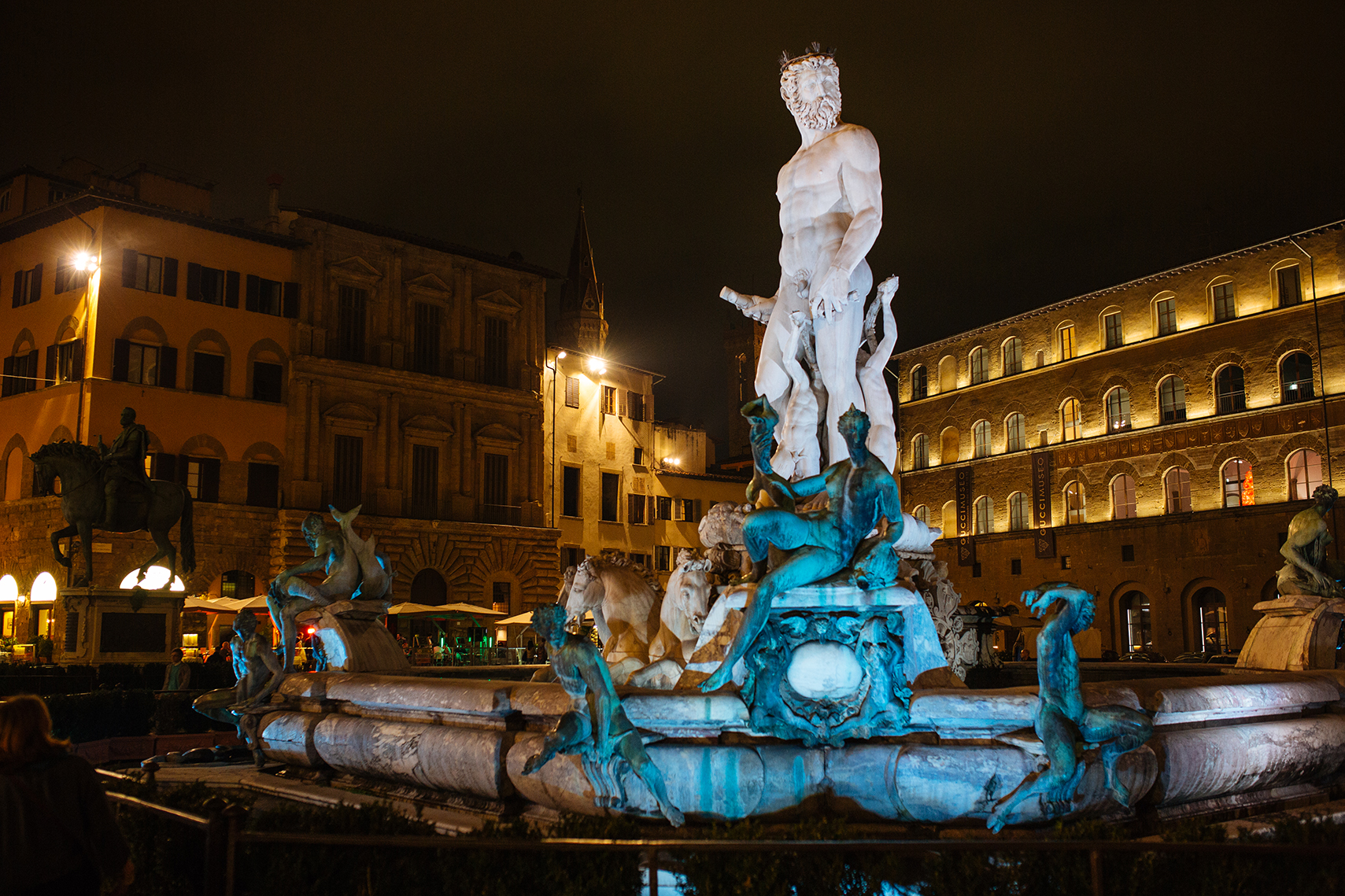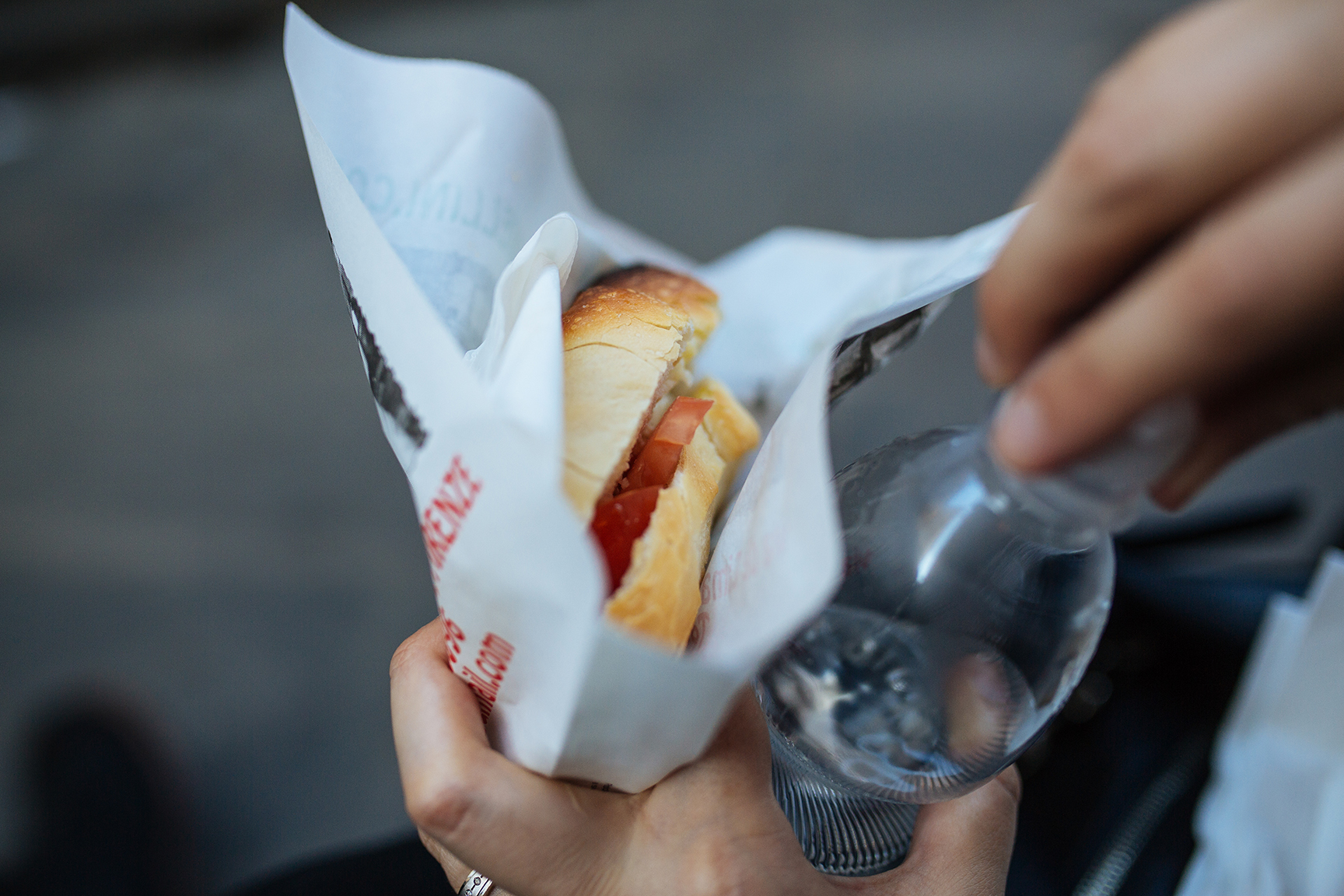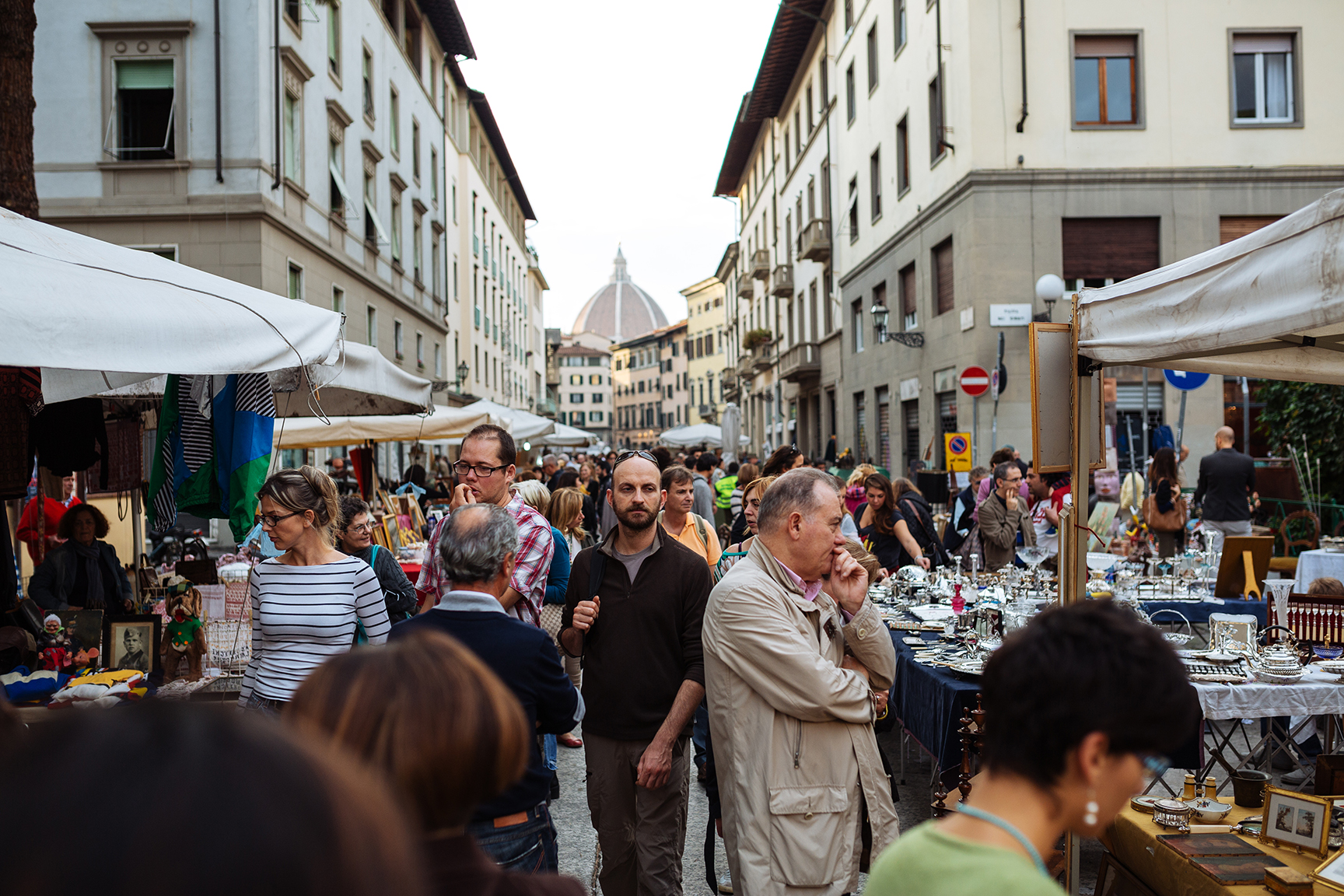The smart thing would be to take a water taxi. We don't do the smart thing. We check out of our hotel in Venice and decide instead to walk to the train station, which, while not terribly far away, is at the end of a twisting route that requires us to cut through crowds, down narrow alleyways, and over numerous bridges, lugging our roller bag behind us. We've packed relatively light—only about thirty-five pounds—but thirty-five pounds quickly gets to be heavy when you're picking up your bag every few steps. We're plenty early for our train, though, so we have a sit-down in some piazza along the way and watch a German photography tour group set up their tripods to take shots of San Giacomo dell'Orio, a church that dates back to the 9th century. My German is nicht so gut, but I can at least tell the group leader is giving some instructions on aperture settings. I'm sad to leave Venice; I was just getting a feel for it.
The station is a madhouse. We thought we'd dodge the morning rush by taking a lunch-time train—and maybe we did—but it's still a hectic scene. Juli calls me The Travel Nazi; I like to get on our bus/plane/train/whatever early and sit patiently until departure, while she's more of an I have three minutes before we leave, so I'm gonna go spend five minutes in the duty-free shop type of person. We balance each other out. She makes sure we're well stocked for drinks and snacks, and I make sure the train doesn't leave without us. We pull out of Venice and watch the Tuscan scenery glide by—low, flat, just-harvested farmland giving way to sloping hills. Chalk-white gravel roads lined with cypress trees and sagging power lines. Clay-red rivers. Persimmon trees. Derelict castello and warehouses with their windows busted out and their roofs caved in. The growing and the falling apart, all of it beautiful.
The Florence train station is somehow busier than Venice's. We get a bit lost looking for our hotel—we take a left when we should've taken a right—but we ask for directions twice and then feel stupid when we realize the hotel is literally across the street from the station. We also discover that it's nothing like the photos we saw online when we booked it. We were expecting clean and modern, but this place is a drab, shabby mess with peeling wallpaper. It takes twenty minutes for the clerk to look up our reservation, and the whole time, Juli and I are sending each other I have a bad feeling about this looks. It gets worse when we get to our room, which has nicotine-yellow walls and stinks—intensely—of harsh cleaning chemicals and bug spray. (I wish I had remembered to take a photo, but we were too depressed.) This isn't what we wanted from our vacation, and with Juli pregnant, she's especially sensitive to smell. We have a small-scale mutual meltdown, but pull ourselves together and decide that we'll stay here tonight, but see what we can do to cancel the rest of our reservation and find some place nicer.
To make an absurdly long story short, we do just that the next morning—arrange for a refund and go literally next door to a sleek, modernist hotel with a single room available for one night only. We take it. Juli cries with relief. For the remaining two nights, we decide to splurge a little and book a room in NH Porta Rossa, one of the oldest hotels in Europe, a gorgeous building that's changed hands numerous times, of course, but has been in continuous use as a lodging place since the 12th century. The clerk even upgrades us to a suite. Hardwood floors. Four-poster bed. Marble bathroom with dual rain-style showerheads. We're in heaven.
Coming from car-less, empty-at-night Venice, Florence is initially somewhat overwhelming. But it quickly grows on us. Our first night—seeking an escape from our DDT-smelling hotel room—we go out walking and find Piazza della Signoria, where we have dinner and the best hot chocolate of our lives at Caffe Rivoire. Afterwards, I take some photos of the statues of Perseus and Hercules and Giambologna's Rape of the Sabine Woman across the square in the Loggia dei Lanzi, a magnificent stone pavilion that adjoins the Uffizi Gallery.
The next morning, after sorting out our hotel drama, we pop briefly into the Basilica di Santa Maria Novella, but by this point in the trip we're feeling a bit like we did during our years in Japan with Shinto shrines—if you've seen one opulent Gothic/Early Renaissance church, you've seen 'em all. But maybe it's just that we're eager to do as much as we can today, especially considering how much time we had to spend on Skype with Hotwire when we could've been out hitting the streets. Plus, we're really excited to see the connected Officina Profumo-Farmaceutica di Santa Maria Novella, which dates back to 1612. It's the oldest pharmacy on the continent, and one of the oldest businesses period. Of course, when I say "pharmacy," I don't mean some florescent-lit QVC or Walgreens where you can pick up Maybelline eyeliner, toilet paper, and bulk bags of peanuts M&Ms all in one go. This place, inside a former chapel, stocks the original elixirs concocted by Dominican monks in the 15th century—including "anti-hysteria" drops for women—along with soaps and potpourris, skin care and liqueurs, teas and fragrances. Juli is a junkie when it comes to this stuff, and I'll freely admit that I enjoy it too. We stock up; you can find some of these products in high-end boutiques or Neiman Marcus, but suffice it to say that they're much, much less expensive here.
Afterwards, we grab a standing lunch at I Due Fratellini, a famed closet-sized sandwich shop where you can get a freshly-made panino and glass of wine for under 5€. The line stretches down the alley and almost around the block, but it's worth it. Also worth the wait is the line to get into the Uffizi Gallery, which we visit next. One of the highlights of our trip is seeing Botticelli's Birth of Venus and Allegory of Spring—both impressively huge, both more vivid and detailed in person than they ever could be in a print. The museum itself is a work of art, with two wings—each lined with sculptures—looking down on a central courtyard. There's also a rooftop terrace where I surprise a group of middle-aged Japanese women by offering—in my broken, basic Japanese—to take a group photo of them. Later, we spot a Japanese couple having a destination wedding right in the Uffizi courtyard.
By the time we leave the Uffizi it's approaching sunset, so while Juli waits in a cafe below, I decide to climb the 414 steps to the top of Giotto's Campanile, a 278-foot bell tower that overlooks the city and gives a spectacular view of "Il Duomo," the dome of the Florence Cathedral. I'm legitimately winded when I get to the top, but my timing is perfect for the height of golden hour. On my way back down, I pass a huffing and puffing Japanese couple and give them a hearty ganbatte kudesai—"Keep it up!" / "Do your best!" / "You can do it!"—earning my second look of bemused surprise for the day. For dinner, we visit Trattoria Anita, a simple place with great, weirdly inexpensive food that Juli remembers from her last trip here, nine years ago. We sit next to a vacationing couple from Tallahassee and make small talk; the husband looks like an older, grandfatherly version of Homeland and Band of Brothers star Damian Lewis. From here, we wander over to Festival del Gelato, a neon-colored gelateria near the Piazza della Repubblica (the square where the Italian Futurist poets used to hang out). For some reason, we keep inexplicably calling the place "Gelatomania."
We wake up decently early the next day and take a 45-minute train ride and a 15-minute taxi lift to the fabled Prada outlet, Space, a low-slung matte black warehouse out in the Tuscan nowheresville of Montevarchi. Inside is a discount luxury wonderland teeming with bargain hunters—us included—and an elegant (and surprisingly warm) sales staff. The deals aren't quite as good as Juli remembers from her last trip—when she netted three pairs of shoes for 30-40€ each—but both of us find some pieces we'll wear to death. We're both into the idea of buying fewer but better-crafted clothes. In having a curated, functional wardrobe that lasts. At least, that's the ideal. On the way back to Florence, Juli nearly gets stuck in a train station restroom that self-cleans after each use—the door locks and the interior gets sprayed down—which might've put an awful-but-hilarious damper on our post-shopping glow.
In the afternoon, we cross the Ponte Vecchio, one of the bridges over the Arno, cut down a back street—where we happen to pass a church just as a new bride and groom emerge to be rice-bombed—and make our way to Le volpi e l'uva, a tiny, crowded wine bar near Palazzo Pitti. Juli can't drink, obviously—I want to get her a shirt that says "Five Months Sober"—but I have two glasses, one for each of us, and we split a platter of local cheeses with bread and fig jam. This powers us up for a stroll through the Boboli Gardens—with its grottos and sculptures and hedgerows—just as the sun starts setting. We walk for a bit behind a Lebanese couple who speak to their young son in a mix of French and Arabic, bringing Juli back to her own childhood.
For our final day in Florence, we do a lot of wandering and last-minute gift buying, along with making a few reprisal visits to some of our favorite spots (I Due Fratellini and "Gelatomania" and, yes, one last look around the Santa Maria Novella Pharmacy). In the morning, we happen past the Alinari National Museum of Photography, and of course I have to go in and check it out. Meanwhile, Juli sits in an outdoor cafe and gets the stink-eye from a pair of German tourists, who are perhaps angry about the whole spying-on-Angela-Merkel business that just blew up in the news that morning. After, we cut east through the city center, taking a series of narrow streets where I start to develop an obsession with the random bicycles we see leaning up against graffitied walls or chained to posts. We stop in the Piazza di Santa Croce to take in the basilica where Galileo and Michelangelo are buried, and then head to the Mercato della Pulci, Florence's largest flea market, with vendors selling everything from antique books and WWII memorabilia—including a disconcerting number of Nazi medals—to 300-year-old garden statues, mid-century typesetting equipment, and fur hats. We're lucky enough to be here on the last Sunday of the month, when the market expands and takes up several streets. It takes almost three hours to make our way through it all, but that could be because I'm taking photos every three steps. I want to buy everything, but we purchase only a single souvenir—a matted page from a vintage 1930s-era Italian children's book to hang in the nursery we're prepping for our soon-to-be daughter.
Our return to Seattle the next day is a step-by-step disaster—in short, we get ripped off by a taxi driver leaving Florence, are waylaid by the hurricane moving through the English channel, miss our connecting flight in Detroit, and are forced to spend the night in an apocalyptic-looking Best Western outside the airport—but at the very least, it puts into perspective how wonderful the rest of the trip has been.
Next up: figuring out how to travel with a baby...


